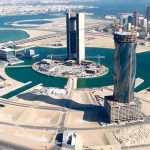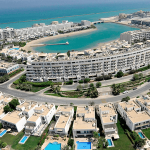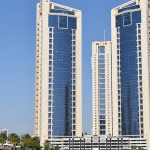While many viewers in Bahrain real estate market were expecting a drastic collapse to take place in the kingdom’s property sector due to the oil price crisis, the small island showed a lot of resilience to an extent that made many analysts reconsider their perception of the kingdom’s capabilities.
In its report published by the end of last year, Cluttons stated that Bahrain’s residential sector showed a significant agility unlike what was expected.
However, this does not mean that Bahrain real estate market is in its finest state. As a matter of fact, it’s passing through one of its most crucial crossroads that would define its fate in the coming few years.
An eye on the past
As urban landscape in Bahrain was getting larger and taking new shape, investors’ appetite was getting growing also looking for grabbing a share in the new promising market.
Since opening the door for foreigners to purchase on Bahraini land in 1999, the market stayed on rise achieving unprecedented growth rates and numbers.

The growth climax is perceived to be during the period between 2012 and 2014, or what’s known as the recovery stage.
The real estate investment environment at that time was very appealing; the market was again radiant after years of hibernation due to the global financial crisis, which had a deep impact on all GCC markets.
Investors also were enthusiastic about buying in the Kingdom, price growth rates were gaining momentum, and construction activity was scoring extraordinary figures.
In 2013, construction sector contributed by 6.91% in Bahrain GDP and the total value of real estate transactions reached BHD1.2 billion for the first time ever.
Development current was flowing with the same momentum in 2014 until oil prices took the hit by the end of the year and dropped down by more than 50%. This meant an inevitability of major changes to happen on the whole real estate scene.
A hard turn
At once after taking the first shot, many development activities came to stall. Governments and investors had to take some moments to reassess the market’s new proportions, and also to reconsider their moves.
The inertia in economic development had a negative effect on job creation rates, government expenditure rates, and real estate development.
On the ground, market growth rate took much slower motion after a significant drop in demand.

Price growth rates have also been hampered, we are talking about both sale and rental prices here, as the property pipeline kept on supplying more units despite the drop in demand.
This meant that Bahrain real estate investment returns became as luring as before, which affected investors’ sentiments.
Factors adding to the market instability
We are still in the wake of this crisis. Low oil prices, despite achieving some recovery over the course of last year, are overcasting the market activity.
However, market sloth in growth pace can’t be only attributed to barrel price, but also other additional facts which we are going to mention in specification.
- Low agility of market components
Reaction to the sector’s drop wasn’t swift from entities and real estate firms. It took them some time to realize the market’s new proportions.
Developers kept on launching and delivering new upmarket projects, unaware of the change in investors’ appetite.

Supply surged, while demand on classic high-end investment units wasn’t as vibrant as before. Shadows of a major market glut was looming in sight, which subsequently forced real estate investment firms to reassess their production policies.
- Inaction of real estate laws
In an attempt to set a clear and definitive framework for the real estate activities, Bahrain government issued the property development law in mid-2014.
The main aim of the new law was to guarantee buyers’ and owners’ rights and boost investors’ confidence in Bahrain real estate market.
Despite the issuance of the executive regulation and orders necessary to implement the provisions of the law, it’s still vague for many developers and the law hasn’t been fully applied in reality.
- Stalled projects
Representing a heavy burden on Bahrain economic leadership and decision makers, the stalled projects are real sore to the eye.

However, Bahrain government is making significant strides towards settling this problem. Last year, a ministerial committee for stalled real estate projects was created to find remedy for this specific problem.
The committee achieved some progress in this case. As a matter of fact, some stalled projects have been already reinstated and are currently awaiting the return of construction and development works.
- Arab investors
Khaliji investments have always constituted a remarkable share in Bahrain’s total real estate transactions value.

Last year, GCC real estate investments value dropped for the second year in row. The total value of property transaction deals reached BHD36 million compared to BHD72 million in 2015, to drop by 49%.
It’s worth mentioning that the total value of real estate deals made by GCC investors has amounted to BHD108 million in 2014.
This serious decline, especially witnessed last year, goes back by large to investors’ negativity and low sentiment buoying on the economic and financial instability in the whole region.

By putting last year under scrutiny, we found that GCC transactions value dropped quarter-on-quarter hitting BHD12.35 in Q1, BHD9.51 million in Q2, BHD9 million in Q3, and BHD5.8 million in Q4.
- Absence of tourism development
Given the major transformations happening in Dubai and Turkish urban landscape, tourism has proved to be a vital catalyst in real estate sector development.
Despite its advantageous touristic elements, Bahrain is still missing a lot of lucrative opportunities in this regard.
Still the kingdom is lacking large-scale tourism facilities that could really interest tourists and investors to hit the island.
For example, Bahrain hasn’t yet taken advantage of its magnificent beaches and islands. Except for one or two, the kingdom doesn’t have attractive sea-front resorts offering full-scale of beach activities.
Facts of Bahrain real estate today
As Bahrain kept losing its premiere point of strength, good return on investment and high capital appreciation rate, the market lost its radiance day after another.
The price growth rates of 20% and 30% per annum, especially in the freehold areas, became things of the past. Properties could barely hit 10% rise in price, and in only certain locations.
Real estate investment companies became less interested in launching new projects due to the uncertainty in the market and unfavorable situation.
The government’s currently pursued policy of reducing expenses, as a result of the dropping oil prices, had also a hand in holding back real estate growth rates, especially on the commercial sector.
This was very apparent on the administrative properties or office spaces, which witnessed a significant stability in demand and price growth.

Individual investments also were affected. Total real estate transactions value in Bahrain reak estate market hit BHD1.1 billion in 2016 compared to BHD1.2 billion in 2015.
Ali Alawadhi, marketing director of Weetas Real Estate, described the market after 2014, especially from mid-year of 2015 until the beginning of 2016, as “partially flat”.
Alawadhi stated another fact that led to the current market situation, which is freezing the issuance of residential permits for foreign property owners.
Many foreign real estate investors, especially those from other Arab countries, aimed by buying properties in Bahrain at seeking refuge from their war-torn countries.
Main driver of the market now

By checking 2016 market statistics, the volume of Arabs’ purchases constituted around 10% of total real estate transactions while nationals’ purchases were accounted for 85%. This indicates that Bahrainis are still the market backbone.

In a special statement to Weetas, the chairman of Bahrain Real Esate Association “Nasser Al Ahli”, said that Bahrainis are the main driver of the market nowadays.
Referring to Bahrainis’ property purchases which dropped only for 12% last year, compared to 49% for Arabs, Al Ahli said that there are no indications of further drops in nationals’ investments with Bahrainis’ sights mainly set towards villas, lands, and apartments in local areas.
The local real estate market is making good performance as demand and supply rates converge, according to Al Ahli.
This trend has urged brokerages and marketing agencies to give closed localities more focus. Moreover, real estate investment companies are expected to launch quality projects in closed markets to exploit its current radiance.
Looking for alternative solutions
The latter changes have formed new reality in the market that will absolutely oblige the main active components to adapt different and more responsive work styles.
Real estate investors should apply more progressive work process. Thorough market and feasibility studies should be conducted before launching any project.
Moreover, investors should turn to providing smarter real estate products designed to meet customers’ needs in the first place.
However, breaking the current stalemate isn’t investors’ responsibility only. Solutions need achieving real synergy between government, financial institutions, and companies.
Patience is a virtue
Actualizing recovery is a long process that shall take some time, however, Bahrain is seen to be on the right track diversifying its economy and reducing its dependence on oil revenues, in an attempt to cast a stable economy with multiple resources of income.
Patience doesn’t mean probing the market from apart waiting for recovery. On the other hand, overvaluation of property prices isn’t also a solution, it’s apparent that 2013 and 2014 profits aren’t realizable any more, at least for this period of time.
So, it’s better to get in action with today’s rules. The field is open for new fact makers, and survival is always for the fittest; those enjoying the highest capabilities of adaption to new situations.








.jpg)
.png)












.jpg)